Advances in PBT Binder and Its Application in Propellants
Abstract
1. Introduction
2. Research on Synthesis and Properties of PBT Binders
2.1. Study on Synthesis of PBT Binder
2.2. Research on Properties of PBT Binder
3. Study on PBT-Based High-Energy Solid Propellants
3.1. Study on Energy Performance of PBT Propellants
3.2. Study on Technological Performance of PBT Propellants
3.3. Study on Mechanical Properties of PBT Propellants
3.4. Study on Combustion Performance of PBT Propellants
3.5. Study on the Safety Performance of PBT Propellants
4. Conclusions
Author Contributions
Funding
Data Availability Statement
Acknowledgments
Conflicts of Interest
References
- Chen, R.S.; Zheng, J. Theoretical calculation method for structural parameters of chemical crosslinked PU elastomer networks. J. Explos. 1996, 35–42. [Google Scholar]
- Shao, C.M.; Xu, G.Y.; Shen, X.M.; Yu, H.J.; Hu, C.; Li, F.L. Effect of infrared transparency of CR/PU blended adhesive on the emissivity of coating. Polym. Mater. Sci. Eng. 2010, 26, 47–49. [Google Scholar]
- Celina, M.; Graham, A.C.; Gillen, K.T.; Assink, R.A. Minier, L.M. Thermal Degradation Studies of a Polyurethane Propellant Binder. Rubber Chem. Technol. 2000, 73, 678–693. [Google Scholar] [CrossRef]
- Chaturvedi, S.; Dave, P.N. Solid propellants: AP/HTPB composite propellants. Arab. J. Chem. 2019, 12, 2061–2068. [Google Scholar] [CrossRef]
- Dennis, C.; Bojko, B. On the combustion of heterogeneous AP/HTPB composite propellants: A review. Fuel 2019, 254, 115646.1–115646.15. [Google Scholar] [CrossRef]
- Zeng, Y.; Huang, W.; Chen, J.X.; Xu, J.S.; Chen, X.; Wu, R.; Song, Q.X. Analysis of thermomechanical coupled accelerated aging of HTPB propellants. Propellants Explos. Pyrotech. 2024, 49, 18. [Google Scholar] [CrossRef]
- Gao, H.; Liu, J.; Sun, Z.; Zhang, F. Mechanistic analysis and performance comparison of core-shell assembled molecular perovskite energetic materials in HTPB propellant. J. Alloys Compd. 2025, 1022, 180040. [Google Scholar] [CrossRef]
- Yin, Y.J.; Dong, Y.; Li, M.L.; Ma, Z.L. Simultaneously altering the energy release and promoting the adhesive force of an electrophoretic energetic film with a fluoropolymer. Langmuir 2022, 38, 38–45. [Google Scholar] [CrossRef]
- Pang, W.Q.; Fan, X.Z.; Zhang, L.B. Progress in study on the energetic adhesive for solid propellant. Chem. Adhes. 2008, 30, 46–49. [Google Scholar]
- Xu, W.; Wang, X.J.; Liu, X.X.; Li, Z.L. New progress in the research of energetic adhesives. Rocket. Propuls. 2007, 33, 44–47. [Google Scholar]
- Luo, Y.J.; Ge, Z. Research progress of azide energetic adhesives. Fine Chem. Ind. 2013, 30, 374–377. [Google Scholar]
- Jia, Z.N.; Zhou, Q.H. Dynamic viscoelastic analysis of nitrocellulose, double base binder and modified double base propellant. J. Beijing Inst. Technol. 1984, 3, 75–83. [Google Scholar]
- Xiao, L.Q.; Qu, B.; Zhou, W.J.; Liu, X.G.; Liu, H.N.; Li, J.Z. Analysis of quality difference of nitrocellulose and its influence on the properties of propellant products. J. Explos. 2024, 47, 372–380. [Google Scholar]
- Liu, B.L. Transesterification Process and Modification of Aliphatic Polyether Polyurethane Elastomers. Ph.D. Thesis, University of Science and Technology, Shanghai, China, 2025. [Google Scholar]
- Liu, L.B.; Wen, W.D.; Liu, H.M.; Y, L.P. Study on mechanical properties of polyurethane elastomers based on tetrahydrofuran polyether. Spec. Rubber Prod. 2001, 22, 21–24. [Google Scholar]
- Wu, W.; Li, H.; Shen, Z.; Cui, H. Research on Constant Speed Tension and Compression Mechanical Properties of Azide Polyether Propellant. Propellants Explos. Pyrotech. 2022, 47, 3–11. [Google Scholar] [CrossRef]
- Zhang, X.M.; Wu, W.; Jin, P.; Ding, S.J.; Liu, S.; Zhao, S.; Yang, W.; Liu, W.H.; Luo, Y.J. Effect of azide polyether pyrolysis property on combustion and heat release of boron-based fuel-rich propellant. Combust. Flame 2022, 245, 112269. [Google Scholar] [CrossRef]
- Wang, G.; Luo, Y.J. Characterization of P(BAMO/AMMO) ETPE Prepared Using Different Diisocyanates. Propellants Explos. Pyrotech. 2016, 41, 850–854. [Google Scholar] [CrossRef]
- Wang, K.; Li, H.; Li, J.Q.; Xu, H.X.; Zhang, C.; Lu, Y.Y.; Fan, X.Z.; Pang, W.Q. Molecular dynamic simulation of performance of modified BAMO/AMMO copolymers and their effects on mechanical properties of energetic materials. Sci. Rep. 2020, 10, 18140. [Google Scholar] [CrossRef]
- Kong, L.Z.; Dong, K.H.; Jiang, A.M.; Yang, C.L.; Tang, Y.H.; Xiao, Y.D. Molecular simulation study of the stabilization process of NEPE propellant. Def. Technol. 2023, 25, 220–230. [Google Scholar] [CrossRef]
- Jin, L.; Qian, J.; Fang, Q.Z.; Hu, Q.W.; Yu, M.H. Study on mechanical properties of solid propellant NEPE. Propellants Explos. Pyrotech. 2023, 48, e202200338. [Google Scholar] [CrossRef]
- Wen, Z.C.; Zhao, X.; Li, H.P.; Huang, X.F.; Wang, F.; Li, W.; Tang, G.; Feng, M.Y. Molecular Dynamics Simulation of the Pyrolysis and Oxidation of NEPE Propellant. Propellants Explos. Pyrotech. 2022, 47, e202200159. [Google Scholar] [CrossRef]
- Zhao, Y.B.; Luo, Y.J.; Li, X.M. Synthesis and characterization of BAMO/GAP random copolymer. Polym. Mater. Sci. Eng. 2012, 28, 1–4. [Google Scholar]
- Tang, G.; Zhang, Z.J.; Li, X.Y.; Luo, Y.J. BAMO-THF copolymer-based energetic thermoplastic polyurethanes with a decent bonding property. Energetic Mater. Front. 2021, 2, 32–39. [Google Scholar] [CrossRef]
- Jia, X.Z.; Tang, L.J.; Liu, R.P.; Liao, H.J.; Cao, L.; Tang, X.Q.; Cao, P. Analysis of interfacial adhesion properties between PBT azide propellant matrix and defective AP fillers using molecular dynamics simulations. Polymers 2024, 16, 3497. [Google Scholar] [CrossRef]
- Zhao, R.; Song, X.D.; Pei, J.F.; Huang, D.Y.; Li, Y.; Pu, L.; Xue, W. Research progress of BAMO based copolymer in solid propellant. China Adhes. 2022, 31, 61–66. [Google Scholar]
- Manser, G.E.; Fletcher, R.; Shaw, G.C. High Energetic Binders Summary Report to Office of Naval Research; Report; Office of Naval Research (ONR): Arlington, VA, USA, 1984. [Google Scholar]
- Maksimowski, P.; Kasztankiewicz, A.B.; Kopacz, W. 3, 3- Bis(azidomethyl) oxetane (BAMO) synthesis via pentaerythritol tosyl derivates. Propellants Explos. Pyrotech. 2017, 42, 1020–1026. [Google Scholar] [CrossRef]
- Qu, H.X.; Feng, Z.G.; Yu, Y.Z. Synthesis of 3,3-bis (azidomethyl) oxacyclobutane tetrahydrofuran copolyethers. J. Explos. 1998, 10–12. [Google Scholar]
- Zheng, Q.L. Study on Epoxy Curing System of Azide Adhesive and Its Application in Gunpowder. Ph.D. Thesis, Nanjing University of Science and Technology, Nanjing, China, 2017. [Google Scholar]
- Qu, H.X.; Feng, Z.G.; Tan, H.M.; Xu, B.G.; Zhou, J.Y. Synthesis and chain structure analysis of 3, 3-bis (azide methyl) epoxybutane-tetrahydrofuran co-polyethers. Acta Polym. Sin. 1997, 615–619. [Google Scholar]
- Wang, Y.S. Synthesis and property evaluation of BAMO polymer. J. Solid Rocket. Technol. 1992, 12, 67–76. [Google Scholar]
- Zheng, W.F.; Li, Y.N.; Li, W.X.; Pan, R.M.; Lin, X.Y. A 3, 3-Diazo-Methyloxocyclobutane-Ethylene Glycol Energetic Copolymer Ether with an Alternating Multi-Block Structure and Its Synthesis Method. Patent CN202110893838.8, 2021. Available online: https://xueshu.baidu.com/usercenter/paper/show?paperid=17500mw0jj7r0620ec2y0vq06n177696&site=xueshu_se&hitarticle=1 (accessed on 15 April 2025).
- Guo, Z.X.; Sun, L.P.; Shao, J.L.; Li, K.; Han, J. Research progress of 3,3-dioxacyclobutane (BAMO) based azide polyethers. In Proceedings of the National Conference on Chemical Propellants of Chinese Chemical Society, Nanjing, China, 20–23 October 2011. [Google Scholar]
- Wang, J.; Huang, H.Y.; Yang, J.G.; Xiao, L.Q.; Zhou, W.L. Synthesis and characterization of branched 3, 3-diazide methyl epoxybutane tetrahydrofuran. J. Solid Rocket. Technol. 2017, 40, 5–10. [Google Scholar]
- Toshio, M.; Naminosuke, K. Energetics of BAMO. Propellants Explos. Pyrotech. 1992, 17, 5–9. [Google Scholar]
- Kubota, N. Combustion of Crystalline and Polymeric Materials, Propellants and Explosives: Thermochemical Aspects of Combustion, 2nd ed.; Wiley-VCH Verlag GmbH & Co., KGaA: Hoboken, NJ, USA, 2007; pp. 113–142. [Google Scholar]
- Chen, H.R.; Zhou, J.W.; Chen, J.F.; Wan, D.H.; Zhang, H.K.; Mao, C.L.; Wang, R. Study on the reaction mechanism of PBT with curing agent. Chin. J. At. Mol. Phys. 2022, 39, 7. [Google Scholar]
- Li, Y.; Tao, W.B.; Li, G.P.; Luo, Y.J. Study on curing reaction kinetics of PBT binder by FT-IR method. Energetic Mater. 2022, 26, 572–577. [Google Scholar]
- Ren, X.; Jin, P.; Li, J.; Li, G.P.; Luo, Y.J. Curing rheological properties of PBT/N-100 adhesive system. Aerosp. Mater. Technol. 2022, 45–52. [Google Scholar]
- Zhao, H.P. Study on Mechanical Properties of 3, 3-Diazide Methyloxybutyl-Tetrahydrofuran Copolymer. Master’s Thesis, Beijing Institute of Technology, Beijing, China, 2017. [Google Scholar]
- Li, Y.; Ma, S.; Li, G.P.; Luo, Y.J. Mechanical properties and network structure integrity of PBT/N-100 binder system. J. Solid Rocket. Technol. 2018, 41, 197–202. [Google Scholar]
- Chen, C.; Wang, Y.X.; Chen, J.F.; Deng, L.; Mao, C.L.; Zhou, X. Study on thermal aging properties of PBT energetic elastomer. Propellants Explos. Pyrotech. 2023, 48, e202200233. [Google Scholar] [CrossRef]
- Chen, C.; Pan, H.Q.; Tu, J.Y.; Chen, J.F.; Zhang, X.Y.; Mao, C.L.; Zhou, X. Thermal aging mechanism of PBT energetic elastomer based on the evolution of microstructure. Mater. Today Chem. 2023, 32, 101655. [Google Scholar] [CrossRef]
- Sha, B.S.; Na, X.D.; Xia, Z.X.; Yan, X.T.; Li, Y.; Huang, L.Y. Experimental study on the combustion characteristics of aluminized nitrate ester plasticized polyether solid propellant under high pressure. Acta Astronaut. 2022, 193, 100–109. [Google Scholar] [CrossRef]
- Fan, S.F.; Li, Y.J.; Li, J.Q.; Xie, W.X.; Yang, H.T. Analysis of energy characteristics of azide-based solid propellants containing ADN or TKX-50. Explos. Mater. 2019, 48, 12–18. [Google Scholar]
- Wu, Z.W.; Liu, X.F.; Ji, M.W.; Zhao, J. Preparation and properties of reduced smoke PBT propellant. Explos. Mater. 2019, 48, 17–22. [Google Scholar]
- Zhang, X.L.; Gan, L.; Deng, A.H.; Niu, C.P.; Zhuang, R. Properties of reduced smoke propellant formulation based on PBT. J. Solid Rocket. Technol. 2021, 44, 69–74. [Google Scholar]
- Wang, H.G. Experimental study on low temperature mechanical properties of HTPB solid propellants at different strain rates. J. Missiles Arrows Guid. 2018, 38, 12–18. [Google Scholar]
- Lai, J.G.; Chang, X.L.; Wang, C.X. Research progress of low temperature mechanical properties of solid propellants. J. Explos. Explos. 2013, 36, 1–8. [Google Scholar]
- Xie, W.X.; Zhao, Y.; Liu, Y.F.; Huang, H.; Zhang, W. Influence factors on mechanical properties of 3, 3-diazide methyloxybutyl-tetrahydrofuran copolyether propellant. New Chem. Mater. 2022, 48, 163–165. [Google Scholar]
- Li, Y.; Jiang, L.; Yin, B.W.; Song, Q.; Liu, Y.J.; Liao, H.D. Research on mechanical properties optimization of PBT-based insensitive low signature solid propellant. J. Solid Rocket. Technol. 2021, 44, 479–485. [Google Scholar]
- Hu, Y.W.; Zuo, H.L.; Zheng, Q.L.; Tu, R.J.; Zhang, H.K.; Zhou, W.L. Creep behavior of composite solid propellant based on PBT at high temperature. J. Solid Rocket. Technol. 2018, 41, 41–46. [Google Scholar]
- Shen, Y.H.; Zhang, Y.C.; Tong, L.L. Study on adjustment technology for high temperature mechanical properties of PBT insensitive high energy propellant. J. Propuls. Technol. 2018, 39, 2595–2600. [Google Scholar]
- Zhang, Z.; Zeng, G.W.; Zhang, Z.J.; Shen, Y.W.; Li, Y.N. Low temperature mechanical properties of PBT solid propellant. J. Propuls. Technol. 2022, 43, 379–385. [Google Scholar]
- Hu, Y.W.; Song, X.D.; Yang, W.L.; Kang, J. Stress Relaxation Behavior of Azido Propellant Based on BAMO-THF at High Temperatures. Materials 2025, 18, 19. [Google Scholar] [CrossRef]
- Yu, H.Y.; Huang, L.; Nie, Z.B.; He, W.X.; Zhou, X. Combustion of ammonium dinitramide based solid propellant with PBT as energetic binders. Propellants Explos. Pyrotech. 2024, 49, e202300231. [Google Scholar] [CrossRef]
- Song, J.G.; Zhang, A.J.; Xu, Y.B.; Zhan, F.L.; Li, W. Study on Reducing Burning Rate of PBT Composite Propellant; Chinese Chemical Society: Beijing, China, 2013; Available online: https://xueshu.baidu.com/usercenter/paper/show?paperid=1b300x70193x04w0au0c0ph0vk181116&site=xueshu_se (accessed on 15 April 2025).
- Wang, R.X. Research on boron-containing BAMO/THF propellant for monolithic engine. J. Propuls. Technol. 1996, 17, 87–90. [Google Scholar]
- Ge, Z.C. Study on Safety Characteristics and Ignition Growth Law of PBT Based Insensitive Propellant. Master’s Thesis, Nanjing University of Science and Technology, Nanjing, China, 2021. [Google Scholar]
- Wu, F.; Xiong, Z.N.; Yan, W.G.; Han, L.P.; Zhou, S.P. Safety properties of Bu-NENA/PBT propellants. J. Solid Rocket. Technol. 2019, 42, 483–487. [Google Scholar]
- Wang, X.; Xu, S.; Li, M.M.; Liu, D.; Wu, X.; Xu, F.; Yang, N. Influence of insensitive oxidants on low vulnerability of PBT-based propellants. J. Ordnance Equip. Eng. 2022, 43, 7–12, 18. [Google Scholar]
- Li, Y.; Wang, X.Q.; Liu, J.; Niu, C.P.; Wu, B.; Gan, L.; Lin, F.; Zhou, Y.H. The relationship between thermal decomposition characteristics and slow cook-off behavior of PBT-based propellants. Equip. Environ. Eng. 2022, 19, 43–49. [Google Scholar]
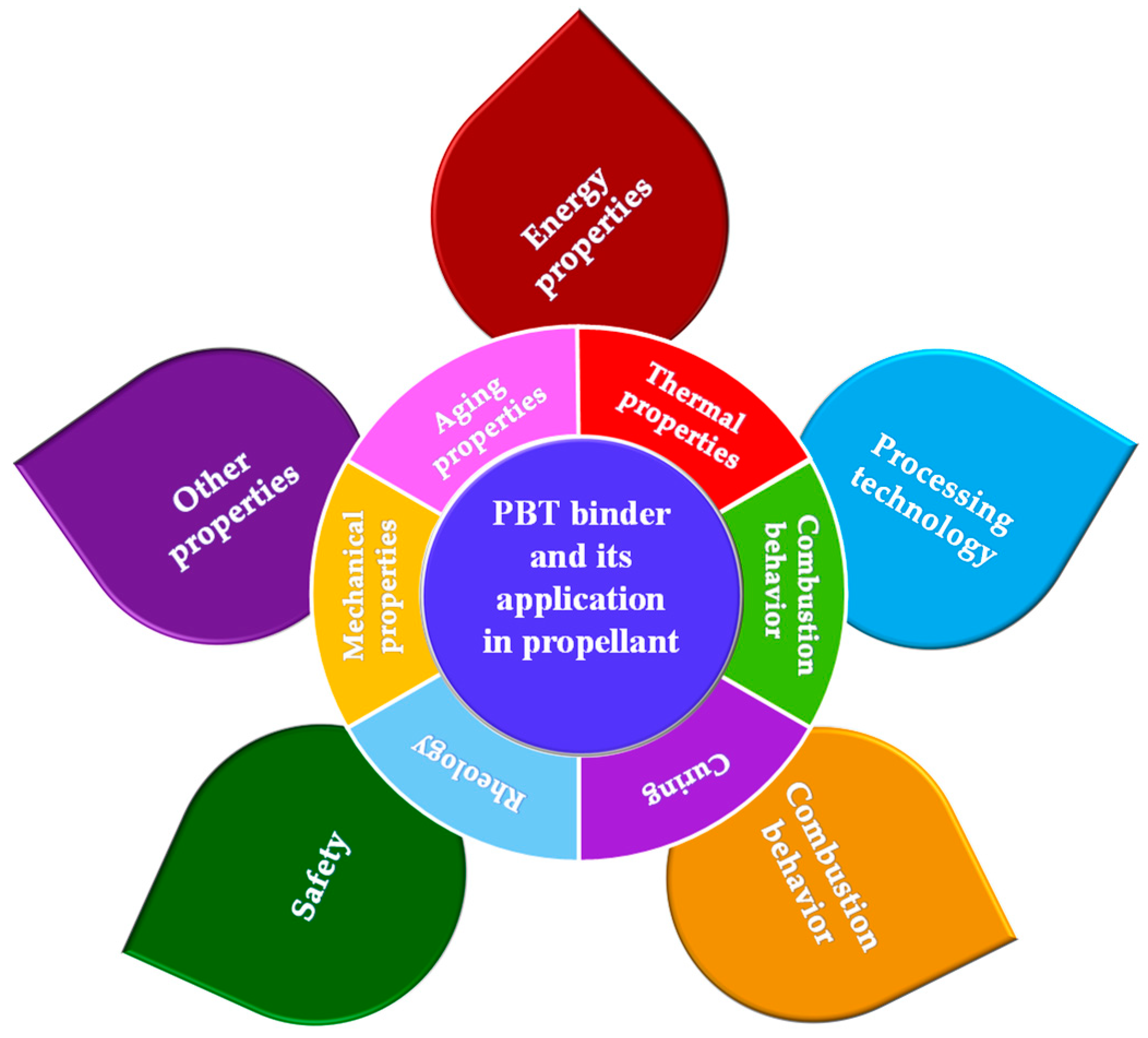

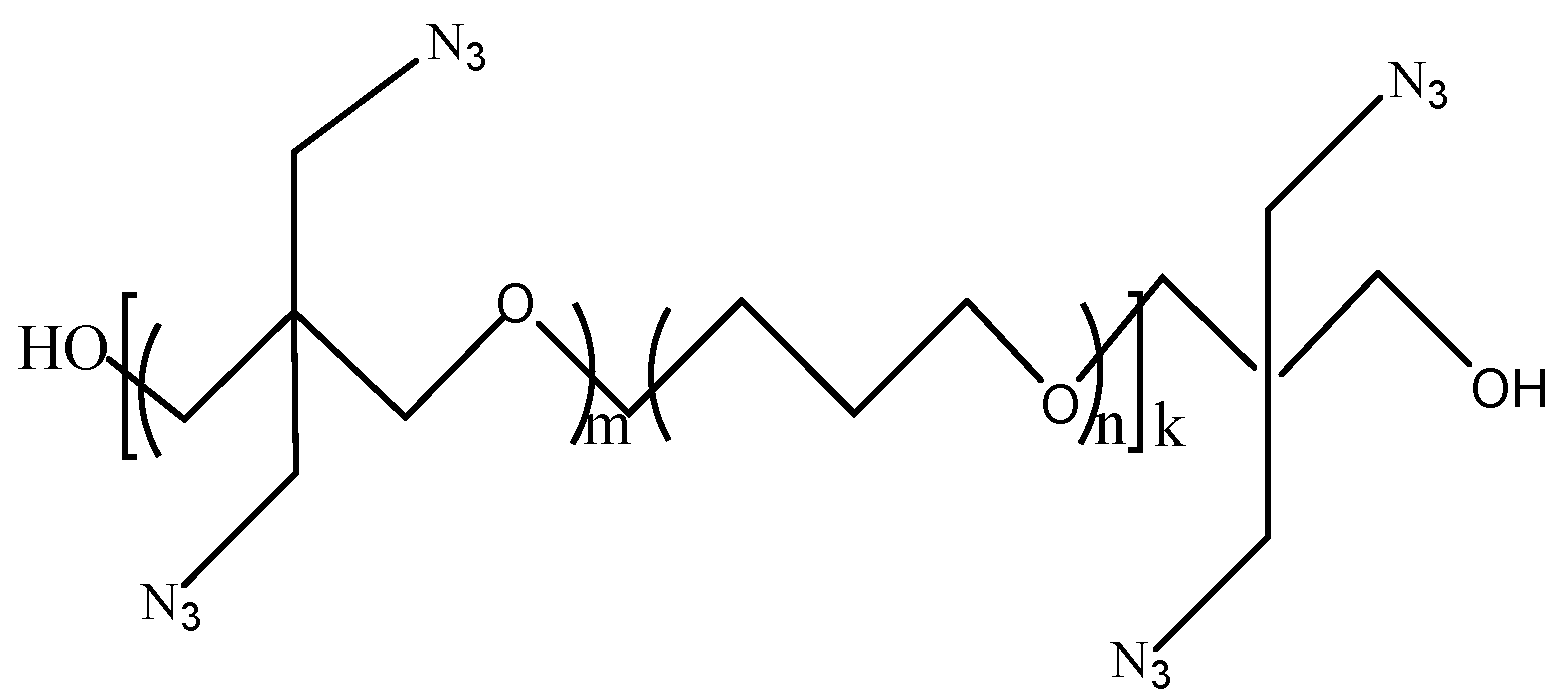
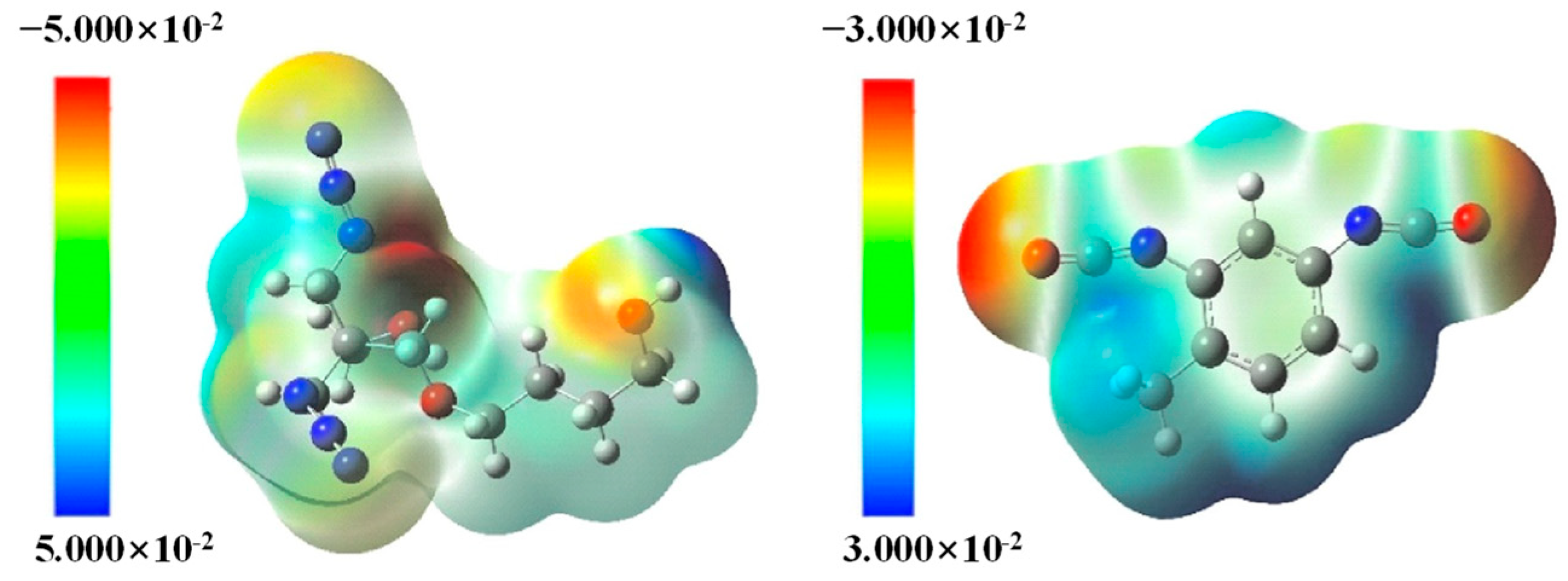

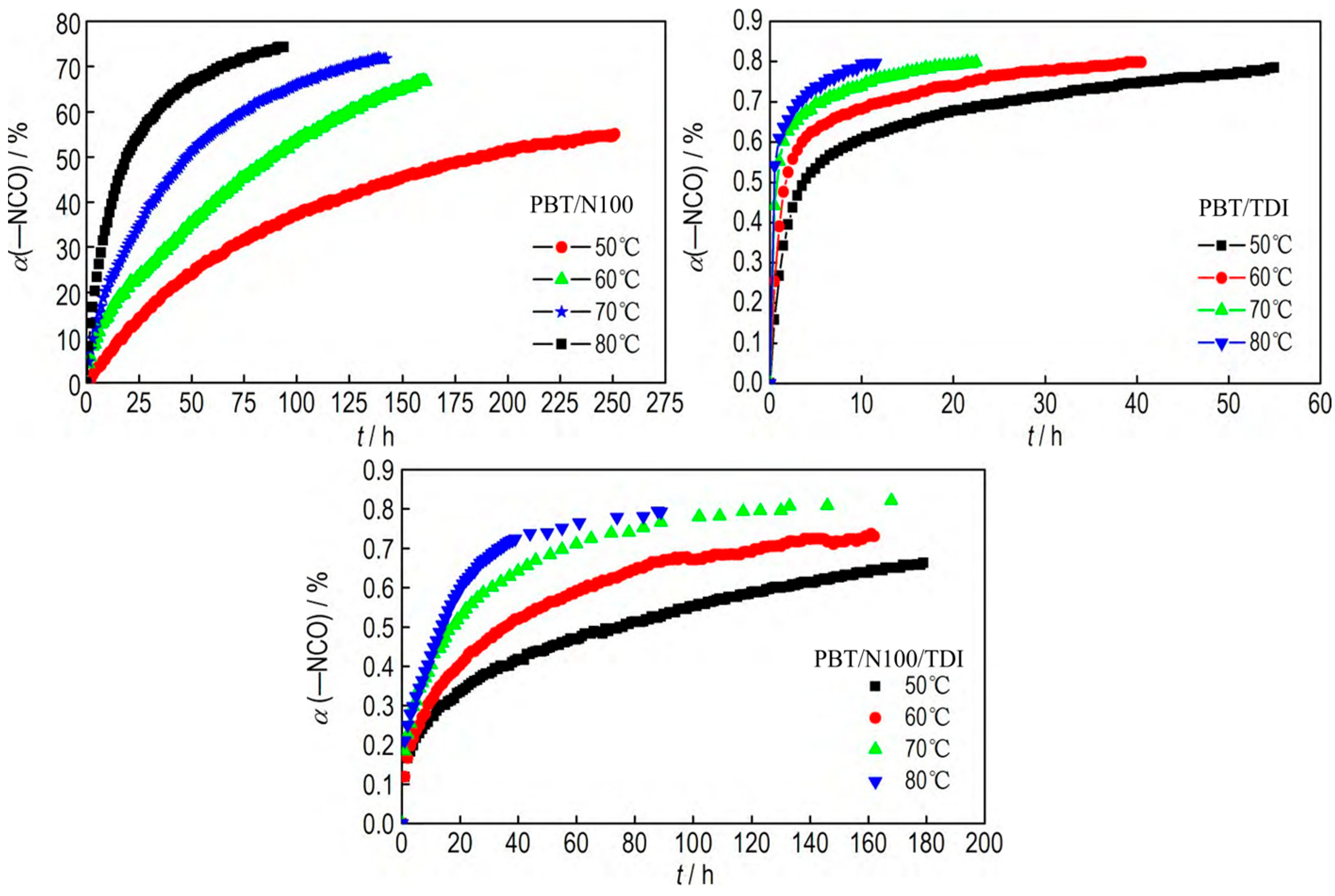
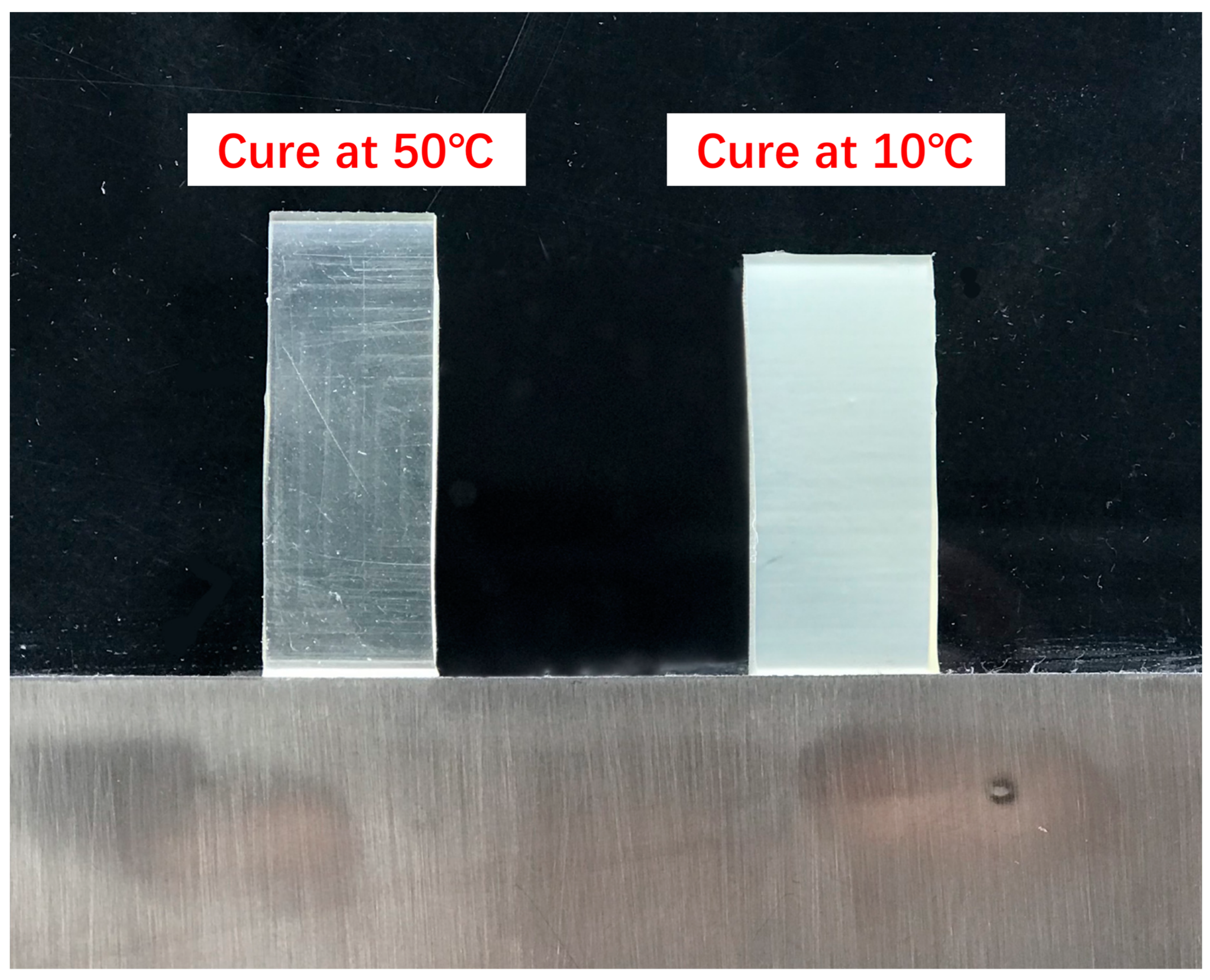



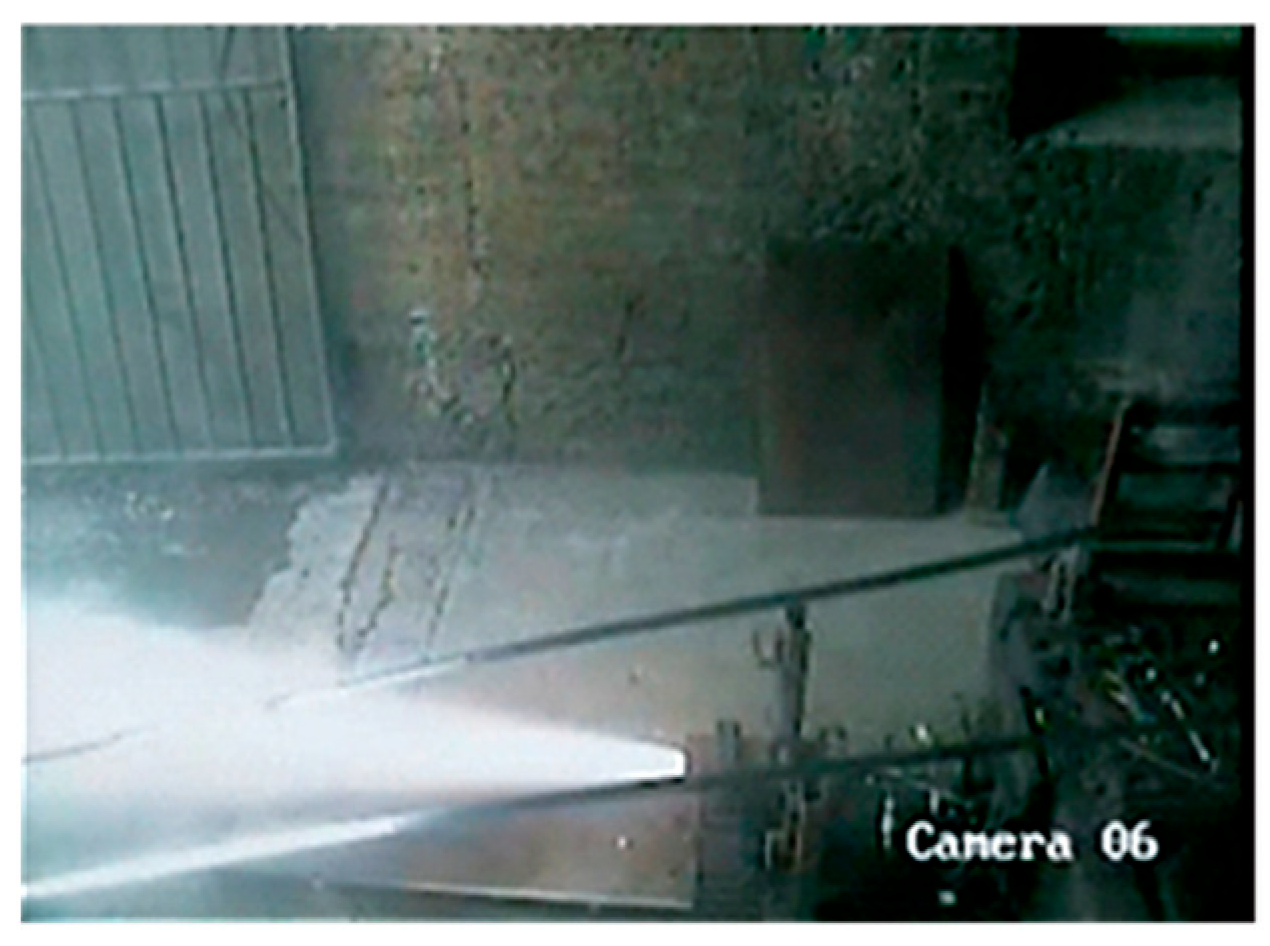
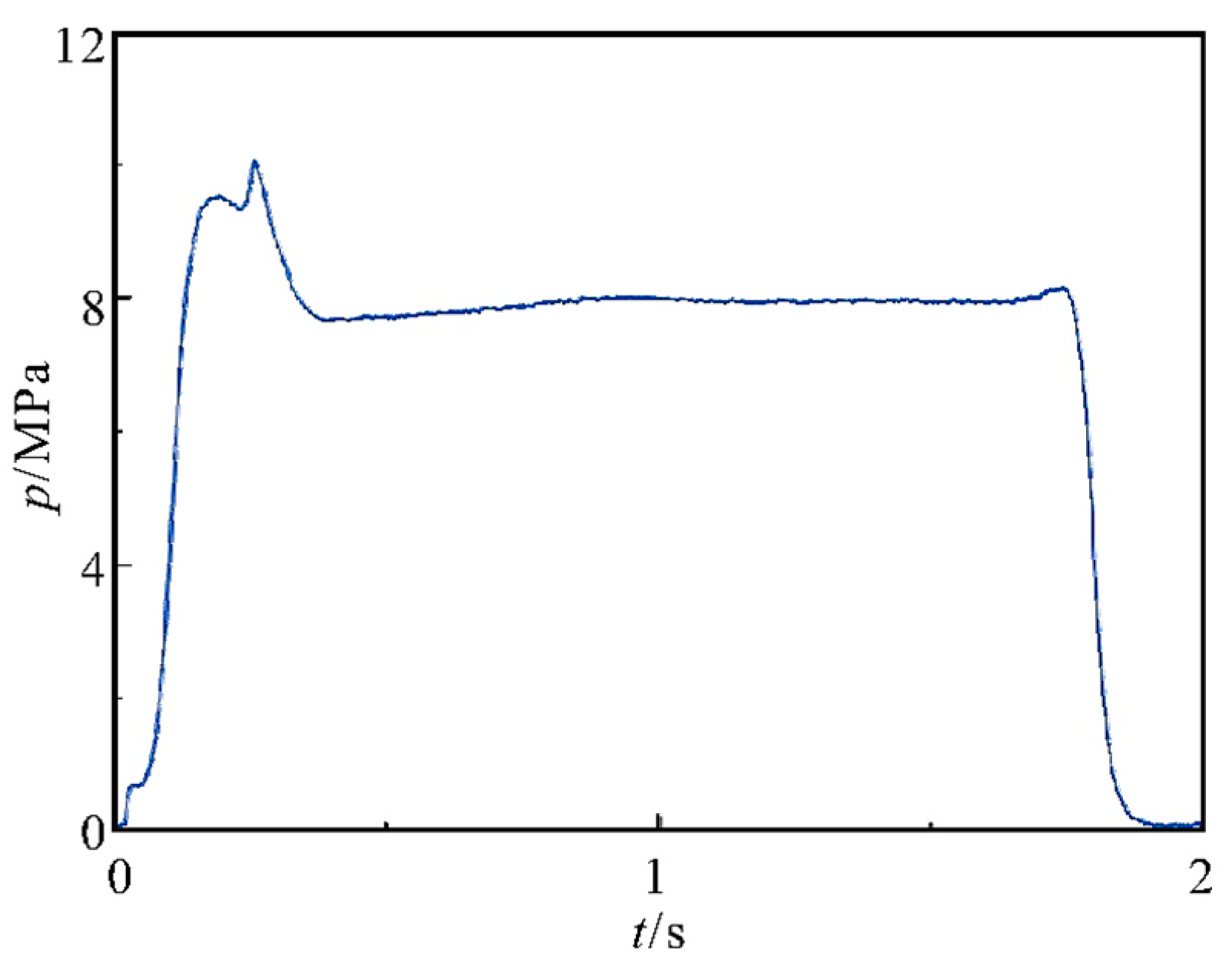



| Parameters | Values |
|---|---|
| Mean molecular weight (g·mol−1) | 2240 |
| Density (g·cm−3) | 1.27 |
| Melting point (°C) | −27 |
| Glass transition temperature (°C) | −61 |
| Enthalpy of formation (kJ·kg−1) | 1185 |
| Adiabatic combustion temperature (°C) | 851 |
| R Value | σm (MPa) | εm (%) |
|---|---|---|
| 0.8 | 0.902 | 220 |
| 0.9 | 0.963 | 143 |
| 1.0 | 1.119 | 121 |
| 1.1 | 1.329 | 125 |
| 1.2 | 1.296 | 118 |
| 1.3 | 1.345 | 116 |
| 1.4 | 1.362 | 115 |
| 1.5 | 1.365 | 120 |
| 1.6 | 1.355 | 117 |
| 1.7 | 1.354 | 110 |
|
PEG (%) |
TN-J (%) | 20 °C | 70 °C | −55 °C | Tg (°C) | |||
|---|---|---|---|---|---|---|---|---|
| σm (MPa) | εm (%) | σm (MPa) | εm (%) | σm (MPa) | εm (%) | |||
| 0.1 | 0.2 | 1.01 | 57.2 | 0.60 | 42.7 | 4.62 | 70.0 | −68.94 |
| 0.1 | 0.3 | 1.12 | 44.3 | 0.73 | 37.5 | 3.90 | 45.0 | −68.30 |
| 0.2 | 0.4 | 1.30 | 41.6 | 0.68 | 32.2 | 4.36 | 61.8 | −65.59 |
| 0.3 | 0.2 | 0.90 | 67.5 | 0.61 | 46.2 | 3.67 | 73.9 | −70.10 |
Disclaimer/Publisher’s Note: The statements, opinions and data contained in all publications are solely those of the individual author(s) and contributor(s) and not of MDPI and/or the editor(s). MDPI and/or the editor(s) disclaim responsibility for any injury to people or property resulting from any ideas, methods, instructions or products referred to in the content. |
© 2025 by the authors. Licensee MDPI, Basel, Switzerland. This article is an open access article distributed under the terms and conditions of the Creative Commons Attribution (CC BY) license (https://creativecommons.org/licenses/by/4.0/).
Share and Cite
Zhang, N.; Gao, X.; Luo, Y.; Zhang, W.; Xin, Y.; Zhang, K.; Xue, C.; Zhang, H.; Wei, J.; Wang, H. Advances in PBT Binder and Its Application in Propellants. Polymers 2025, 17, 1151. https://doi.org/10.3390/polym17091151
Zhang N, Gao X, Luo Y, Zhang W, Xin Y, Zhang K, Xue C, Zhang H, Wei J, Wang H. Advances in PBT Binder and Its Application in Propellants. Polymers. 2025; 17(9):1151. https://doi.org/10.3390/polym17091151
Chicago/Turabian StyleZhang, Ning, Xifei Gao, Yunjun Luo, Weihai Zhang, Yanping Xin, Kai Zhang, Chen Xue, Han Zhang, Jiao Wei, and Hui Wang. 2025. "Advances in PBT Binder and Its Application in Propellants" Polymers 17, no. 9: 1151. https://doi.org/10.3390/polym17091151
APA StyleZhang, N., Gao, X., Luo, Y., Zhang, W., Xin, Y., Zhang, K., Xue, C., Zhang, H., Wei, J., & Wang, H. (2025). Advances in PBT Binder and Its Application in Propellants. Polymers, 17(9), 1151. https://doi.org/10.3390/polym17091151






